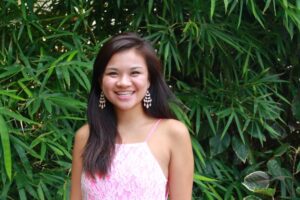In the (Mesophotic) Zone

Princeton student Jenny Zhou, at BIOS during her summer research stay.
Bermudians know that invasive lionfish like to eat their native fish, and that they gobble them in huge numbers. What they don’t know yet is the full range of the lionfish invasion, though increasing evidence shows that lionfish aren’t afraid to go deep for their meals.
For the past two summers, BIOS research specialist Tim Noyes has looked beyond Bermuda’s shallow reefs to depths of 100 to 500 feet (about 30 to 150 meters), an area called the mesophotic zone, where sunlight penetration is low. By deploying baited video cameras off the sides of boats, then counting and categorizing the fish he captures on film, Noyes is attempting to formulate a clearer picture of the activity of lionfish, as well as native fish, in these lesser-understood waters.
To do this work, he relies on the help of students like Jenny Zhou, among a half dozen university interns who worked with Noyes on his lionfish research last year. Zhou was among five students from Princeton University who completed internships at BIOS in 2015. Zhou, a 21-year-old international relations major now completing her senior year, said she came to BIOS to fulfill a goal of learning how to collect data in the field.
“I’ve never done research like this before,” she said, noting that other internships and public sector opportunities worldwide have included data compilation and analyses, primarily in social sciences. With a keen interest in government policy and natural resource management, she said “it was cool to see how science fit in with the policy aspect. It was rewarding to be a part of a 12-week summer project that will, over time, add to the bigger picture of scientists’ understanding of the lionfish issue.”
She doesn’t shy from big challenges (a seasoned traveler with a curious mind, she’s fluent in Chinese, German, Russian, and Spanish), but she laughed when asked to describe her biggest obstacle at BIOS. “I literally could not name one fish when I arrived,” she said. That posed a problem because her internship would require her to name numerous species captured via Noyes’ video cameras. She spent her first week on Bermuda reviewing literature, pouring over fish identification guides, and watching videos of fish captured by Noyes from the previous summer.
She also learned that she was more suited to on-shore lab work than going out to sea. “I got so seasick the first time we went out in the boat,” she said. Instead she relied on Noyes and fellow interns to collect the video, while she annotated their video captures in the lab. “I definitely learned how to tell fish apart,” she said, and the experience of collecting and sorting data and applying it to a scientific study with an important community component was exactly what she felt she needed to round out her Princeton coursework and international internships.
She and another student, Konadu Amoakuh, spent the summer at BIOS through the Princeton Environmental Institute (PEI), designed for science majors looking for a guided research experience. A third student, Emily Avery, came to BIOS through Princeton Internships in Civic Service (PICS), a program for people interested in being of service to a community. Two other Princeton students, Zoe Sims and Vivian Yao, spent time at BIOS as volunteer interns working on coral reef projects.
Noyes said he was glad to have Zhou’s experience in political arenas. “Ultimately I see this type of project as having an applied ending, a tool the Bermuda Government could use for lionfish management purposes,” he said. “It was interesting to have Jenny’s views on how the project could potentially influence policy.”
Zhou is currently finishing coursework at Princeton and has accepted a Boston-based consulting position with the business management firm Bain & Company, where she hopes to be staffed on projects with an environmental focus. Her BIOS project, which included reviewing 150 hours of captured video, generated the most comprehensive dataset of known lionfish sightings. This allowed Noyes and another student to generate a species distribution model. They presented this model at the Gulf Caribbean Fisheries Institute conference in Panama at the beginning of November 2015. Noyes said he is applying for additional funding to create future predictive models for other ecologically important species.
